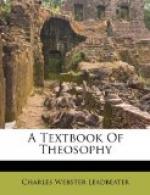When these rates of undulation are awakened within him they show themselves in his causal body as colours, so that instead of being a mere transparent bubble it gradually becomes a sphere filled with matter of the most lovely and delicate hues—an object beautiful beyond all conception. It is found by experience that these colours are significant. The vibration which denotes the power of unselfish affection shows itself as a pale rose-colour; that which indicates high intellectual power is yellow; that which expresses sympathy is green, while blue betokens devotional feeling, and a luminous lilac-blue typifies the higher spirituality. The same scheme of colour-significance applies to the bodies which are built of denser matter, but as we approach the physical world the hues are in every case by comparison grosser—not only less delicate but also less living.
In the course of evolution in the lower worlds man often introduces into his vehicles qualities which are undesirable and entirely inappropriate for his life as an ego—such, for example, as pride, irritability, sensuality. These, like the rest, are reducible to vibrations, but they are in all cases vibrations of the lower subdivisions of their respective worlds, and therefore they cannot reproduce themselves in the causal body, which is built exclusively of the matter of the three higher subdivisions of its world. For each section of the astral body acts strongly upon the corresponding section of the mental body, but only upon the corresponding section; it cannot influence any other part. So the causal body can be affected only by the three higher portions of the astral body; and the oscillations of those represent only good qualities.
The practical effect of this is that the man can build into the ego (that is, into his true self) nothing but good qualities; the evil qualities which he develops are in their nature transitory and must be thrown aside as he advances, because he has no longer within him matter which can express them. The difference between the causal bodies of the savage and the saint is that the first is empty and colourless, while the second is full of brilliant, coruscating tints. As the man passes beyond even saint-hood and becomes a great spiritual power, his causal body increases in size, because it has so much more to express, and it also begins to pour out from itself in all directions powerful rays of living light. In one who has attained Adeptship this body is of enormous dimensions.




